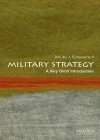A Very Short Introduction
Oxford University Press, 2nd edition, 2024, 133 pp
Paperback ISBN: 9780197760154
AUTHOR: Antulio J Echevarria II
REVIEWED BY: Jordan Beavis
The sheer breadth and depth of scholarship available on military strategy is overwhelming. For centuries scholars and practitioners have debated what military strategy is, how strategies can be categorised, and the factors that can lead to the success or failure of a strategy. This is not to mention the mass of literature dedicated to case studies on the application of strategies in specific historical conflicts or eras, nor contemporary or forward-looking blogs and books advocating the adoption or use of a particular strategy or combination of strategies to address contemporary national security and geopolitical challenges.
Antulio J Echevarria II, then, is to be lauded for his ability to cut away the faff and, within the pages of the second edition of his Military Strategy: A Very Short Introduction, present a concise and incisive introduction to this expansive topic. Echevarria is certainly equipped for this task; a former officer in the US Army, he is currently Professor of Strategy and the General Douglas MacArthur Chair of Research at the US Army War College. He has also written a number of authoritative books on military strategy, and Editor in Chief of the journal Parameters.[1]
The book is structured into eight chapters, with the first chapter comprising an introduction. Here Echevarria ranges widely, drawing upon multiple strands of strategic theory to synthesise an accessible overview of the topic. definition of military strategy, defining it as ‘the practice of reducing an adversary’s physical capacity and willingness to fight, and continuing to do so until one’s aim is achieved.’[2] Military strategy is used in both peacetime and wartime and – unlike grand strategy which is the concern of the head of state – is the business of the military professional. The military professional works within the boundaries developed and imposed by the grand strategist, though military strategy and grand strategy drive each other in a continuing strategic dialogue as context and circumstances change. provides further related definitions too, including on ‘national military strategy’ – how a state uses its military power in pursuit of policy goals – as well as regional or theatre strategies. He also outlines how military strategy is broken down into three components: ends (objectives); ways (courses of action); and means (resources).[3] These components should be balanced to reduce risk and increase chances of success. However, Importantly for military professionals, Echevarria argues that military strategy should not be thought of as either an art or a science, but as a ‘practice’ that combines the ‘objective knowledge of science (insofar as it can be objective) with the subjective knowledge (or skill) associated with an art’.[4] The author completes this introduction by presenting the common types of military strategy, with these the focus of following chapters.
The linked strategies of ‘annihilation’ and ‘dislocation’ are the concern of Chapter Two. Annihilation comprises the intent to reduce an enemy’s material strength through victory in one or two major battles. Such a strategy relies on superior generalship, training, and possibly technology. Echevarria utilises the Battle of Cannae, and the tactic of double envelopment, to illustrate this Dislocation is the endeavour to achieve victory through unexpected manoeuvre that achieves surprise and knocks the enemy off balance psychologically. The most often cited example of a dislocation strategy was the German use of ‘Blizkrieg’ in France in 1940, though Echevarria reminds readers that no such official doctrine actually existed. As strategies, annihilation and dislocation are high-risk and high-reward, and primarily suited to conventional wars. There is great difficulty in achieving either if used against a dispersed foe.
Chapter Three examines the strategies of ‘attrition’ and ‘exhaustion’. These methods are often turned to following the failure of an annihilation or dislocation strategy. Frequently used in conjunction, together they comprise a means to wear down a foe’s physical resources and psychological willingness to continue to fight. Echevarria quips that it is often said that these strategies ‘form the basis of all other military strategies, and there is some truth to this claim’ as every military strategy involves wearing down an adversary’s strength.[5] Attrition is defined as destroying an enemy’s forces faster than they can be replaced while ensuring your own rate of loss remains bearable; it does not require a favourable balance of exchange in each battle, just on average. Exhaustion is a ‘form of psychological attrition’, targeting emotional or intangible factors such as morale and public confidence.[6] An exhaustion strategy can take several forms, including sieges, scorched earth tactics, guerrilla warfare, and blockades, the latter of which was used in the First World War to undermine Germany’s ability to continue fighting. As the author argues, attrition and exhaustion are the ‘Achilles heel’ of annihilation and dislocation strategies, but they require political and cultural patience to employ.
The core principle of deterrence is that, to discourage aggression, one must appear strong enough to defeat an attack or at least make it too costly to be worthwhile. Four types of deterrence are generally identified: direct (deterring an attack against oneself); extended (deterring an attack against a friend or ally); general (deterring a potential threat); and immediate (deterring an immediate attack). As the author notes, the strategy can be a double-edged sword as fears of a foe or competitor’s strength can backfire and invite aggression through a pre-emptive strike. ‘Compellence’ is the ‘inverse’ of deterrence; while deterrence aims to make someone ‘not’ do something, compellence is forcing an action. Compellence can include measures such as punishment, denial, intimidation, and reward. The West’s track record of compellence is mixed. The development of precision air power in the late 20th century saw its potential utility balloon, but its failure in the 1990-91 Gulf War brought a more realistic appreciation of its ability to influence foes and competitors alike. As Echevarria reminds us, both deterrence and compellence can be difficult to practice and have their limitations. They rely on excellent intelligence, a deep understanding of the target’s cultural and psychological boundaries, and credible communication.
‘Terror’ and ‘terrorism’ – and ‘decapitation’ and ‘targeted killing’ – are the subjects of Chapters Five and Six respectively. Terrorism, Echevarria states, is violence ‘directed against non-combatants to influence public opinion or to modify a government’s policies’.[7] Terrorism can be indiscriminate and wholesale and used in an attempt to break civilian morale (as in the mass bombing of British, Japanese, and German cities in the Second World War). It can also be selective and precise, and take the form of political assassinations. While terrorism has been seen by some as a tactic, when used systematically in pursuit of larger policy aims it can become a consistent and coherent strategy. Against a strategy of terrorism ‘from below’ – that is, by insurgencies or revolutionary groups – states can utilise the strategies of decapitation and targeted killing.[8] While these terms are often used synonymously, Echevarria argues that they differ in some key respects. While decapitation aims to eliminate a group’s leadership (through killing or capture), targeted killing specifically involves the death of a target who may not necessarily be a member of the leadership. Both remain controversial strategic techniques, legally and morally, largely used to counter domestic or international insurgencies. In the aftermath of the Afghanistan War, these strategies have also been criticised for being ineffective over the long term.
As the final examination of a strategy, Echevarria examines the use of ‘information warfare’ as facilitated through ‘cyber power’. While cyber power has become an ‘essential instrument of national policy’ and a form of national power, to date its influence on the physical battlefield or physical infrastructure has been exceedingly temporary. In a particularly pithy paragraph, Echevarria notes that cyber power can offer opportunities to weaken a foe’s material capacity, aid in disrupting command and control and lines of supply and communication, inflict financial damage, and influence a state’s citizenry through propaganda and misinformation. However, it cannot physically subdue militaries, capture cities, or overthrow a state. Cyber strategies are not necessarily offensive in nature; Ukraine’s defensive use of cyber power since the Russian invasion in 2022 has expanded the possibilities and scope of use.
Fittingly, the final chapter of Military Strategy: A Very Short Introduction is devoted to exploring some of the factors that cause military strategies to succeed or fail. Here Echevarria reminds us that the practice of military strategy is ‘fraught with misjudgements, miscalculations, and missteps on all sides’, while being ‘easy to understand but difficult to execute’.[9] In general, four elements are required for a strategy to succeed: a critical appraisal of an adversary’s strengths and weaknesses and matching them against one’s own; development of courses of actions that can weaken a foe to reach your goals; a military commander with the knowledge and competence to design and implement a workable strategy; and a ‘coherent and comprehensive’ war plan to pull everything together.[10] Strategies that lack some or all of these elements, and that do not account for other factors (such as incidental friction, weather, misinformation, misunderstandings, bureaucratic inertia, defection, and treason) are not necessarily doomed to failure, but are far less likely to succeed.
Military Strategy: A Very Short Introduction is a highly useful work. While the prose can at times seem laden with exasperation, this is wholly the result of the limitations of the Very Short Introduction format. Echevarria clearly could have filled many more pages on the nuances of each strategy, illustrated through relevant case studies. Yet, with brevity and concision borne out of deep knowledge of the topic, Echevarria has developed an accessible guide for any scholar, practitioner, or amateur. It is a work that should be widely distributed and engaged with by ADF members and Defence public servants alike – it has distinct utility as a baseline to this topic that all members of the Defence Organisation can use, outside of doctrine, to ensure we understand what each other means when we discuss military strategy.
Endnotes
[1] See Antulio J. Echevarria II, Clausewitz & Contemporary War (Oxford University Press, 2007); Antulio J. Echevarria II, After Clausewitz: German Military Thinkers Before the Great War (University Press of Kansas, 2000); Antulio J. Echevarria II, War’s Logic: Strategic Thought and the American Way of War (Cambridge University Press, 2021); and Antulio J. Echevarria II, Imagining Future War: The West’s Technological Revolution and Visions of Wars to Come, 1880-1914 (Bloomsbury, 2007).
[2] Antulio J. Echevarria II, Military Strategy: A Very Short Introduction, 2nd ed. (Oxford University Press, 2024), 1.
[3] This model was developed by Arthur F. Lykke Jr. during the Cold War, but its utility to contemporary strategy development is being called into question by some theorists. See, for example, Andrew Carr, ‘Strategy for a Complex Age: To Frame or Solve?,’ Military Strategy Magazine 10, no. 2 (2025): 18-25.
[4] Echevarria, Military Strategy, 7.
[5] Echevarria, Military Strategy, 31.
[6] Echevarria, Military Strategy, 37.
[7] Echevarria, Military Strategy, 65.
[8] Israel’s use of pagers to attack members of Hezbollah is a recent example of this. See Matt Murphy and Joe Tidy, ‘What we know about the Hezbollah device explosions’, BBC News, 20 September 2024, https://www.bbc.com/news/articles/cz04m913m49o [Accessed 27 May 2025]
[9] Echevarria, Military Strategy, 112.
[10] Echevarria, Military Strategy, 113-14.




